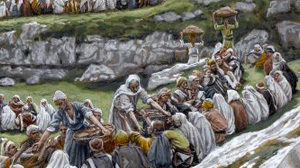Scripture:
Reflection:
The feeding of the 4,000 in Gentile territory in today’s gospel closely parallels Jesus’ earlier feeding of the 5,000 in Galilee (Mk 6:35-44). Scholars point out that both wonders take place in a deserted area, where Jesus feeds a huge crowd with a few loaves and fishes. His blessing and gestures clearly foreshadow the Eucharist. Both highlight the disciples’ lack of faith. Both conclude with abundant leftover bread, the dismissal of the crowd, and a departure by boat.
Scholars, however, also observe that in other details the two stories are notably different. And it is these differences that enrich each Eucharistic story, giving them unique theological topography and terrain. The first feeding in Galilee is with Jews. The second in the pagan region of Decapolis is with Gentiles.
In between these two multiplication wonders is the story of Jesus’ encounter with the Syrophoenician woman begging him to heal her daughter. Despite his rebukes that his food is first for the Jews (“Let the children be fed first, for it is not right to take the food of the children and throw it to the dogs.”) The Gentile woman will accept the scraps that fall from their table.
With her poignant story and her daughter’s healing, Jesus is now breaking the strict wall that the ceremonial laws had created between Jews and Gentiles. This story creates a bridge between the feeding of Jews in Galilee and today’s gospel reading where Jesus feeds the Gentiles.
Notably too, Mark, deliberately and carefully, records the numbers in each feeding miracle, emphasizing their symbolic importance to accentuate Jesus’ reaching out beyond Galilee to strange and forbidden pagan lands.
In Decapolis, Jesus has compassion on the people because they have no food – symbolically the Gentiles did not have “The Word.” In Galilee, Jesus was concerned because the people were as sheep without a shepherd – a typical Old Testament image of Israel.
In Decapolis, there were seven loaves – the symbol of wholeness. In Galilee, there were five loaves – the symbol of covenant.
In Decapolis, seven baskets are gathered up – possibly suggesting the seven pagan nations that inhabited Canaan before Israel entered the land (Deut 7:1). In Galilee, there are twelve – the symbol of the twelve tribes of Israel. Even the baskets described in each story are different. In Galilee, Mark used a term denoting wicker baskets typically used by Jews. In Decapolis, he uses an ordinary Greek word for large baskets.
The number four alludes to the four corners of the world. Thus, Jesus fed four thousand – four times one thousand, the whole world.
Interesting, one might say, but so what?
Well, perhaps, this: today’s gospel reveals that, yes, Jesus, the observant Jew, is the true shepherd and bread of life for Jews. But he also is Messiah to the whole world. And beginning with the Syrophoenician woman who begged for crumbs, Jesus has broken old covenant barriers and laws. He now offers to all the true bread of life – and in abundance.
And this: Jesus made room for difference – difference between Galilee and Decapolis, between Jew and Gentile. Can we do likewise? In our bitterly polarized world, saturated in suspicion, can we make room for differences? Can we recognize God’s image in someone who is not in my image, whose language, faith, and ideals are different from ours?
And finally, this: Every time we receive the Eucharist, nourished with the Bread of Life, we too are challenged to break barriers, tear down walls, and build bridges so that we can see the face of Jesus in others and minister to their particular needs.
Deacon Manuel Valencia is on the staff at Mater Dolorosa Passionist Retreat Center, Sierra Madre, California.
